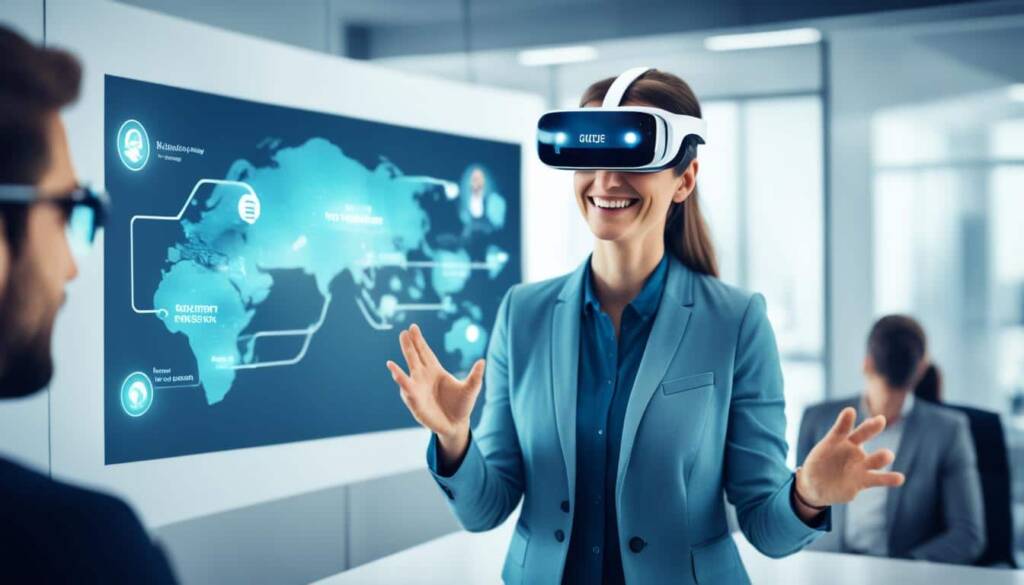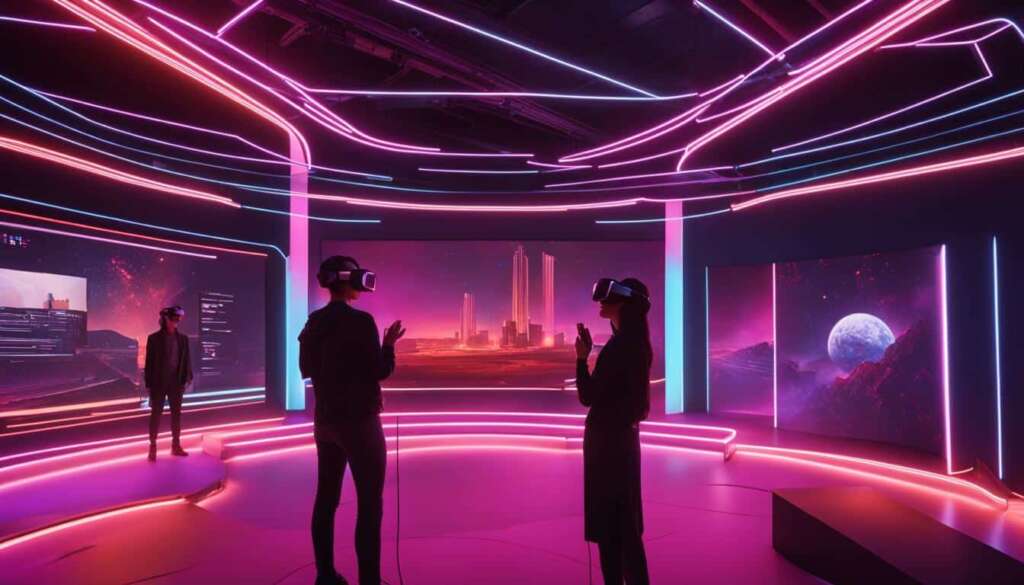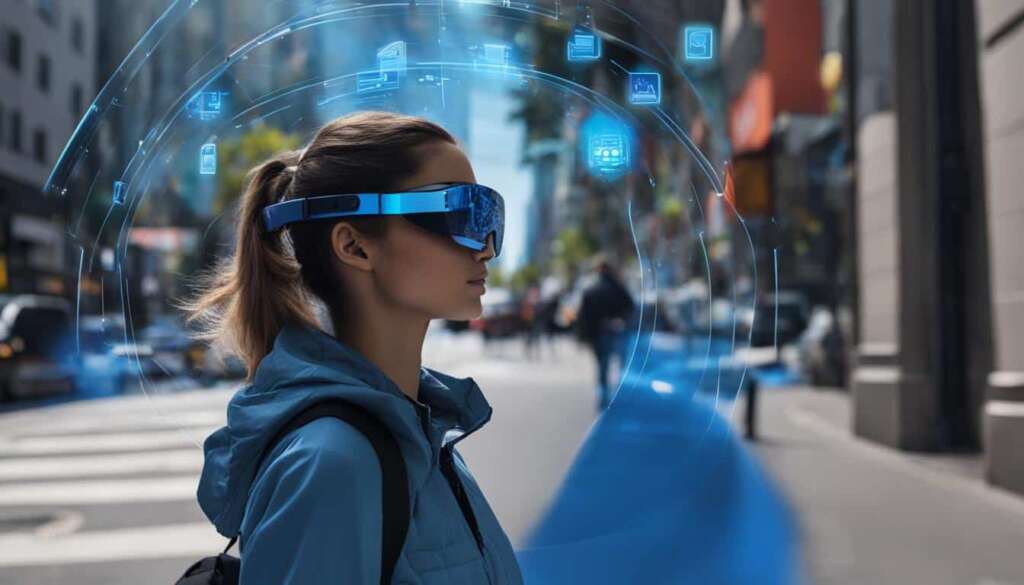Table of Contents
Augmented reality (AR) and virtual reality (VR) technologies have the potential to revolutionize the way we conduct video meetings, addressing the issue of meeting fatigue experienced by remote workers. These immersive technologies offer new opportunities for remote collaboration, providing a more engaging and interactive meeting experience. By exploring the capabilities of AR and VR, we can discover how they can enhance productivity and communication in the world of remote work.
AR and VR can significantly transform video meetings by creating a more immersive and engaging environment. With digital transformation becoming increasingly important, video conferencing has become a vital tool for remote work. However, the standard video meeting format can be exhausting and impersonal. AR and VR technologies have the potential to enhance collaboration and improve communication by providing a virtual space where participants can interact with each other and with digital content. By using AR and VR in video meetings, remote workers can experience a greater sense of presence and engagement, leading to improved productivity and team communication.
The Impact of AR and VR on Video Meetings
AR and VR have the potential to significantly transform video meetings, creating a more immersive and engaging environment. With digital transformation shaping the modern workplace, video conferencing has become an essential tool for remote work. However, the standard video meeting format can often feel exhausting and impersonal, hindering remote team communication and productivity enhancement.
By leveraging the power of AR and VR technologies, video meetings can be revolutionized. These immersive technologies offer a virtual space where participants can interact with each other and with digital content, fostering collaboration and improving communication. Gone are the days of mundane video calls; instead, remote workers can experience a greater sense of presence and engagement, leading to enhanced productivity and team cohesion.
AR and VR provide a unique opportunity for remote workers to actively participate in meetings, bridging the physical distance and stimulating remote team communication. By creating a more interactive and dynamic environment, these technologies enable participants to visualize concepts, manipulate objects, and engage in hands-on experiences, even while working remotely.
Imagine a video meeting where team members can virtually gather around a digital whiteboard, brainstorming ideas and making annotations in real-time. Visualizing complex data through augmented reality overlays could facilitate data-driven discussions and decision-making processes. Virtual reality, on the other hand, offers the potential to transport participants to fully immersive environments, where they can engage in realistic simulations, team-building exercises, or even virtual product demonstrations.
AR and VR technologies truly revolutionize the way remote teams interact and collaborate in video meetings. The enhanced sense of presence and engagement they provide can significantly enhance productivity and remote team communication, ultimately driving digital transformation in the modern workplace.
Benefits and Use Cases of AR and VR in Video Meetings
The benefits of incorporating AR and VR into video meetings are diverse and profound. These technologies have the power to transform remote collaboration and leverage immersive experiences for productivity enhancement. Here are some key advantages and potential use cases:
- Enhanced Collaboration: AR and VR create a shared virtual space where remote team members can collaborate as if they were in the same physical room. This fosters a greater sense of teamwork and enables real-time collaboration on digital content.
- Improved Communication: The interactive nature of AR and VR allows for more engaging and effective communication in remote video meetings. Participants can use gestures, avatars, and spatial audio to convey their ideas and emotions, replicating the nuances of face-to-face interactions.
- Virtual Training: AR and VR can be leveraged for virtual training sessions, where participants can learn new skills, practice scenarios, and receive instant feedback in a safe and immersive environment.
- Data Visualization: Augmented reality overlays in video meetings can assist in visualizing complex data, making it easier for participants to understand and analyze information. This can enhance data-driven decision-making and improve information retention.
- Virtual Product Demonstrations: Virtual reality can be utilized to showcase products and services in a visually immersive way. Participants can explore virtual showrooms, interact with virtual prototypes, and gain a deeper understanding of the features and functionalities.
| Benefits | Use Cases |
|---|---|
| Enhanced Collaboration | Shared virtual space for real-time collaboration |
| Improved Communication | Gesture-based interactions and spatial audio |
| Virtual Training | Skills development and scenario practice |
| Data Visualization | Augmented reality overlays for enhanced data analysis |
| Virtual Product Demonstrations | Immersive showcases of products and services |
These examples illustrate the versatile applications of AR and VR in video meetings and highlight the potential for these technologies to enhance remote collaboration, productivity, and communication.
The Future of AR and VR in Video Meetings
The future of video meetings lies in the seamless integration of AR and VR technologies. As remote work continues to grow in popularity and digital transformation expands, the demand for immersive experiences will only intensify. The upcoming years will witness further advancements in AR and VR, presenting exciting opportunities for transforming the way remote teams collaborate.
Technology companies and video conferencing platforms are actively exploring ways to integrate AR and VR features into their existing solutions. This includes developing more user-friendly interfaces, expanding hardware compatibility, and enhancing the overall user experience. As these technologies become more accessible and user-friendly, the adoption of AR and VR in video meetings is expected to soar.
Furthermore, the combination of artificial intelligence, spatial computing, and 5G connectivity will pave the way for even more advanced AR and VR applications in video meetings. This convergence of technologies will unlock new possibilities for remote collaboration, enabling remote workers to interact with virtual objects and environments seamlessly.
In conclusion, AR and VR have the potential to redefine video meetings, transforming them into immersive and engaging experiences that enhance collaboration, communication, and productivity. As remote work becomes increasingly prevalent in the digital age, embracing these technologies can unlock new levels of creativity, efficiency, and remote team communication.
Benefits and Use Cases of AR and VR in Video Meetings
The benefits of using augmented reality (AR) and virtual reality (VR) in video meetings are vast. These immersive technologies enable remote team members to collaborate as if they were in the same physical room, enhancing remote collaboration and productivity enhancement.
Enhancing Presentations and Data Visualization with Augmented Reality
AR technology allows participants to overlay digital information onto the real world, offering a visually immersive experience during presentations and data visualization. By utilizing AR, remote workers can transform their surroundings and enhance their understanding of complex ideas and concepts.
Interactive and Engaging Discussions with Virtual Reality
VR technology can transport users to a completely virtual environment, opening up new possibilities for interactive and engaging discussions. Remote teams can create a shared virtual space where they can meet, interact with each other, and explore digital objects and environments. This level of immersion fosters remote collaboration and helps overcome the limitations of traditional video meetings.
Virtual Training, Product Demonstrations, and Events
AR and VR have extensive use cases beyond meetings. These technologies can be harnessed for virtual training sessions, allowing remote teams to acquire new skills and knowledge in an immersive and interactive environment. Additionally, AR and VR can facilitate virtual product demonstrations, enabling potential customers to experience products as if they were physically present. Moreover, virtual events hosted with the help of AR and VR technologies offer a unique and engaging experience to participants from remote locations.
In summary, the use of AR and VR in video meetings brings countless benefits to remote teams. From enhancing presentations and data visualization with AR, to fostering interactive discussions and enabling virtual experiences with VR, remote collaboration becomes more immersive, engaging, and productive. The possibilities for adopting these immersive technologies in the remote work landscape are vast, expanding the horizons of how we connect and collaborate in the digital age.
The Future of AR and VR in Video Meetings
The future of remote collaboration and video conferencing looks promising as digital transformation continues to evolve. Immersive technologies such as augmented reality (AR) and virtual reality (VR) have the potential to revolutionize how remote teams collaborate, bridging the gap between in-person and virtual interactions.
As AR and VR technology advances and becomes more accessible, we can expect to see further integration into video conferencing platforms and remote collaboration tools. This integration will create a more engaging and productive remote work environment, ultimately disrupting the exhausting culture of traditional video meetings.
Imagine a future where remote team members can gather in a shared virtual space, interacting with each other and digital content as if they were in the same physical room. AR can overlay important information onto the real world, enhancing presentations and data visualization. VR can transport users to a completely virtual environment, enabling more interactive and engaging discussions.
With the increasing demand for remote work and the continuous evolution of digital transformation, the potential of AR and VR in video meetings is boundless. As these immersive technologies continue to reshape the way we collaborate remotely, the future holds exciting possibilities for remote teams worldwide.
FAQ
How can AR and VR revolutionize video meetings?
AR and VR technologies offer a more immersive and engaging meeting experience, addressing the issue of meeting fatigue experienced by remote workers. These technologies create a virtual space where participants can interact with each other and digital content, enhancing collaboration and communication.
What are the benefits of using AR and VR in video meetings?
AR and VR enable remote team members to collaborate as if they were in the same physical room. AR overlays digital information onto the real world, enhancing presentations and data visualization. VR creates a completely virtual environment for more interactive and engaging discussions. These technologies also open up possibilities for virtual training, product demonstrations, and events.
How can AR and VR disrupt the exhausting culture of video meetings?
By offering a more immersive and engaging meeting experience, AR and VR can enhance productivity and team communication. They bridge the gap between in-person and virtual interactions, creating a shared virtual space for remote collaboration. This disruption can lead to a more engaging and productive remote work environment.
What is the future outlook for AR and VR in video meetings?
As remote work becomes more prevalent and digital transformation continues, the demand for immersive technologies like AR and VR is expected to increase. Integration of these technologies into video conferencing platforms and remote collaboration tools will likely accelerate, leading to further improvements in remote team communication and productivity.













